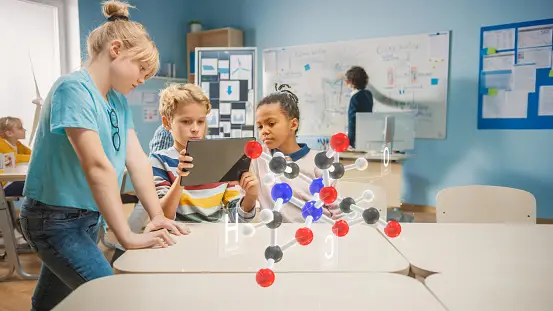Introduction to Technology in Education
Embarking on the digital voyage of today’s education system requires a compass directed toward innovation and learning paradigms shaped by technology. Aspects of tradition in teaching methodologies are now interwoven with cutting-edge digital aids, reshaping the core dynamics between teachers and learners. Incorporating education IT solutions into pedagogic strategies brings about a refreshing approach to instructional delivery and content consumption. It’s more than about convenience; it’s about creating an ecosystem where technology and education amplify each other’s strengths in a symbiotic relationship.
Digital Literacy: Preparing Students for the Future
The digital age has signaled a significant shift in the labor market, necessitating a workforce adept in navigating a landscape where technology reigns supreme. In response to this, educational curricula are evolving, placing a heightened emphasis on digital literacy as a fundamental pillar. Developing digital skills is now optional but imperative for students aspiring to thrive in various career paths. The surge in the volume of information that characterizes our era demands that students and teachers become proficient in discerning the reliability and relevance of online content.
The Role of Interactive Learning Platforms
Education in the digital era is characterized by its emphasis on interaction and engagement. Interactive learning platforms have revolutionized the conventional learning experience, transforming students from passive recipients of knowledge into active contributors within their educational journeys. Gone are the days of monotone lectures directed at rows of disengaged pupils; now, vibrant, interactive sessions captivate learners, fostering an exhilarating learning environment. Such platforms promise a gratifying learning process where immediate feedback is a palpable reality, enabling students to calibrate their understanding and educators to fine-tune instructional strategies as needed.
E-Learning and Distance Education: Breaking Traditional Boundaries
The rise of e-learning and distance education signifies a monumental leap toward inclusivity and accessibility within academia. This modern modality shatters the confines of brick-and-mortar classrooms, erecting vast networks where knowledge transmission knows no bounds. For students in remote or underserved areas and those with physical constraints or challenging schedules, e-learning offers a beacon of hope and a pathway to educational attainment. Even in times of global crises, such as the unprecedented COVID-19 pandemic, e-learning stood as a testament to the resilience and adaptability of educational institutions worldwide.
The Impact of EdTech on Teacher’s Roles
Traditionally perceived as the sole gatekeepers of knowledge, teachers now embrace a morphed role, wherein they act as guides, facilitators, and collaborators in a student’s learning process. This dramatic transition is largely fueled by a plethora of educational technologies that populate modern classrooms — from smartboards to educational software. These tools for collaboration and engagement empower educators to move beyond didactic instruction and toward a more interactive and impactful teaching model.
As the educational landscape becomes increasingly digital, teachers are called upon to acquire new skills and adapt their teaching methods correspondingly. They are expected to harness the power of these technologies not just to impart knowledge but to inspire a deeper understanding and passion for learning. By effectively navigating this digital toolkit, teachers can offer a more customized learning experience, adapting to each student’s needs and learning styles, thereby unlocking a student’s full potential and igniting their intrinsic motivation to learn.
Assessing the Effectiveness of Tech-Integrated Education
With technology deeply embedded in the educational fabric, assessing its impact becomes crucial. Many evaluation tools and mechanisms have been developed to measure the successes and identify areas for improvement within tech-integrated education systems. Studies continue to unveil the positive ramifications of technology use in classrooms, from increased student engagement to improved academic achievements. Diagnostic assessments, learning analytics, and performance tracking are a few techniques that help determine the efficacy of technology integration, allowing educators to tailor their strategies for optimum learning outcomes.
By employing these evaluative methods, educational institutions can distill actionable insights from data, fine-tuning the educational experience to better align with student needs and learning objectives. As a result, the personalization of learning becomes a tangible reality, contributing to higher student satisfaction and retention rates and ultimately leading to more meaningful educational outcomes. Insightful data collected from technology use in education ratifies the significant role that digital tools play in enhancing both the teaching and learning experience.
Enhancing Classroom Collaboration with Technology
Collaboration is central to effective learning, and technology can significantly amplify this collaborative spirit. Cloud-based software and platforms allow students to work together on projects in real time, irrespective of physical distance. This seamless integration of collaborative technologies in education catapults students into a world where collective learning and shared problem-solving become an organic part of the academic experience. These tools offer dynamic and versatile environments where creativity and innovation can blossom through teamwork and cooperation.
Moreover, these technologies also extend the boundaries of the classroom, facilitating global collaboration and cultural exchange among students from various geographical backgrounds. The ease with which people can communicate and work together over vast distances is one of the miracles of modern technology, and conceptualizing this into a learning context prepares students for a globalized workforce.
Navigating Challenges: Privacy, Cybersecurity, and Screen Time
As we herald the digital revolution in education, it’s crucial to acknowledge the inherent challenges accompanying these advancements. The sanctity of personal information is a pressing concern, highlighting the need for robust data privacy mechanisms within educational platforms. Cybersecurity in schools is becoming increasingly relevant, as the digitization of records and online content delivery create potential vulnerabilities that must be meticulously safeguarded. Moreover, the debate over screen time continues to generate discourse, urging moderation and balance to avoid the pitfalls of excessive exposure to digital screens.



